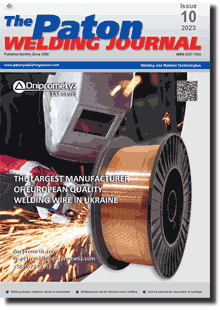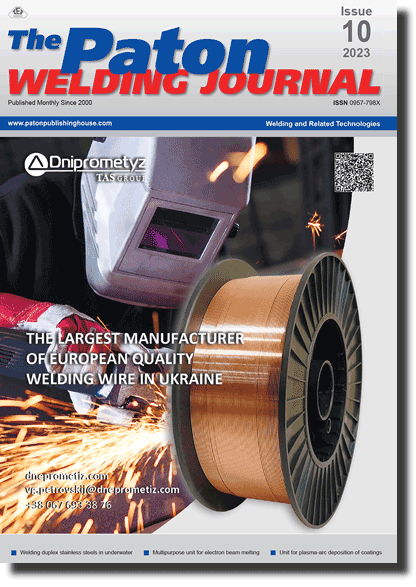Access for download PDF files for subscribers and for reviewers of scientometric bases.
Organization: Elsevier for content access(PDF files of journals released before 2024 are available for download from the website's archives))
Organization: Elsevier for content access(PDF files of journals released before 2024 are available for download from the website's archives))
| 2023 №10 (01) |
DOI of Article 10.37434/tpwj2023.10.02 |
2023 №10 (03) |

The Paton Welding Journal, 2023, #10, 10-17 pages
Features of welding duplex stainless steels in wet underwater welding in comparison with welding in air (Review)
S.Yu. Maksymov, G.V. Fadejeva, A.A. Radzijevska, D.V. Vasyljev
E.O. Paton Electric Welding Institute of the NASU. 11 Kazymyr Malevych Str., 03150, Kyiv, Ukraine. E-mail: maksimov@paton.kiev.uaAbstract
The presented review shows that the main task in welding duplex stainless steels (DSS) is ensuring the conditions which should promote reduction of the negative impact of the welding thermal cycle on the microstructure and change of the initial balance of the phase components, particularly in the high-temperature region of the HAZ. In welding duplex stainless steels the required ratio of ferrite and austenite in the weld metal is provided by changing the chemical composition, and in the HAZ it is achieved due to lowering of the cooling rate. Depending on cooling rate W13/8 or time of soaking predominantly in the temperature range of phase transformations, the respective microstructure of metal the weld and HAZ is formed with the specified ratio of phase components of austenite and ferrite, which, in its turn, affects the mechanical properties and corrosion resistance of duplex steel welded joints. A clear correlation of the mechanical properties is observed, depending on austenite and ferrite content in the weld metal. With increase of the cooling rate, the quantity of precipitates of excess phase, Cr2N chromium nitrides, becomes greater. It was found that in view of intensive cooling impact of the water environment, the volume fraction of austenitic phase is lower in the metal of the weld and in the HAZ high-temperature region in wet underwater welding, compared with volume fraction of the austenitic component in welding in air at the same heat input values. With increase of the energy input, a significant increase of volume fraction of austenitic phase is observed, particularly in wet underwater welding. Considering the features, characteristic for wet underwater welding, the energy input levels and chemical composition of weld metal require correction as regards the recommendations, which were developed for welding in air. 38 Ref., 3 Tabl., 4 Fig.
Keywords: duplex steels, wet underwater welding, energy input, cooling rate, phase composition, austenite, ferrite, microstructure, welding thermal cycle.
Received: 12.07.2023
Accepted: 14.11.2023
References
1. Charles, J., Ehemelle, P. (2010) Proc. оf the 8th Duplex Stainless Steels conference. The history of duplex developments, nowadays DSS properties and duplex market future trends. Beaune: EDP Sciences, Book available on demand.2. Amman, T. (2007) Shielded-gas arc welding of duplex steels. Svetsaren, 62, 1, 41-45.
3. Austenitic-ferritic steels. http://www.weldzone.info: 795 - austenito-ferritnye stali.
4. Verma, J., Taiwade, R.V (2017) Effect of welding processes and conditions on the microstructure, mechanical properties and corrosion resistance of duplex stainless steel weldments - A review. Journal of Manufacturing Processes, 25, 134-152. https://doi.org/10.1016/j.jmapro.2016.11.003
5. Labanowski, J., Eydrych, D., Rogaldki, C., Samson, K. (2011). Underwater welding of Duplex Stainless Steel. Solid State Phenomena, 183, 101-106. https://doi.org/10.4028/www.scientific.net/SSP.183.101
6. Duplex stainless steel. http://www.outokumpu.com.
7. Lippold, J.C., Kotecki, D. (2005) Welding metallurgy and weldability of stainless steel. Joh Wiley and Sons, Inc. 186 p.
8. DSTU EN ISO 3581: 2021. Welding materials. Covered electrodes for manual arc welding of stainless and heat-resistant steels. Classification.
9. How to weld Duplex Stainless Steels; Document 10601 EN - CB; Avesta welding AB: Avesta, Sweden, 2006.
10. Welding Guidelines for Duplex & Superduplex Stainless Steels; Metrode Products Ltd.: Chertsey, UK, 2006.
11. Pettersson C.-O., Fager S.-Å., Welding Practice for the Sandvik Duplex Stainless Steels SAF 2304, SAF 2205 and SAF 2507; Technical Document S-91-57; AB Sandvik steel; Stockholm, Sweden, 1995.
12. DIN EN 1011-3: 2019 Schweiβen - Empfehlungen zum Schweiβen metallischer wekstoffe - Teil 3. Lichtbogen Schweiβen von nichtrostenden Stӓhlen.
13. DSTU EN ISO 1011-3: 2021. Welding. Recommendations for welding metal materials. Pt 3. Arc welding of stainless steels.
14. Welding of duplex stainless steels. http://www.avestawelding. com/4976.epibrw.
15. http://www.bohlernn.ru.
16. Sandvik SAF 2205 Sandvik Materials Technology. http:// www.smt.sandvik.com/en/materials-center/material-datasheets/ tube-and-pipe-seamless/sandvik-saf-2205.
17. Kotecki, D.J. (2010) Some pitfalls in welding of duplex Stainless Steels. Soldagem & Inspecao, 15, 4, 336-343. https://doi.org/10.1590/S0104-92242010000400011
18. Bermejo, M.A.V., Daniel, E., Hurtig, K., Karlsson, L. (2019) A New Approach to the Study of Multi-Pass Welds- Microstructure and Properties of Welded 20-mm-Thick Superduplex Stainless Steel. Applied Sciences., 9, 18 p. https://doi.org/10.3390/app9061050
19. Gupta, A., Baskaran, A.K.T., Arya, S.B., Khatirkar, R.K. (2018) Effect of Heat Input oh Microstructure and Corrosoin Behavior of Duplex Stainless Steel Shielded Metal Arc Welds. Transactions of the Indian Institute of Metals., 71. 1595-1606. https://doi.org/10.1007/s12666-018-1294-z
20. Verma, J., Taiwade, R.V., Khatirkar, R.K. et al. (2016) Microstructure, Mechanical and Intergranular Corrosion Behavior of Dissimilar DSS 2205 and ASS 316L Shielded Metal Arc Welds. Trans. Indian. Inst. Met., 70. https://doi.org/10.1007/s12666-016-0878-8
21. Labanowski, J. (1997) Duplex steels - new material for chemical processing industry. Engineering and Chemical Equipment, 2, 3-10.
22. API 582-09. Welding guidelines for the chemical, oil, and gas industries.
23. Norsok M-630, Edidition 6. Oktober 2013. Material data sheets and element data sheets for piping.
24. Muthupandi, V., Bala Srinivasan, P., Seshadri, S.K., Sundaresan, S. (2003) Effect of weld metal chemistry and heat input on the structure and properties of duplex stainless steel welds. Materials Science and Engineering A358, 9-16. https://doi.org/10.1016/S0921-5093(03)00077-7
25. Higelin A., Manchet S., Passot, G. et al. (2022) Heat-affected zone ferrite content control of a duplex stainless steel grade to enhance weldability. Welding in the world, 66, 1503-1519. https://doi.org/10.1007/s40194-022-01326-0
26. Kurintsev, S.V. (2020) Analysis of influence of welding method on phase composition and internal stresses of welded joints of austenitic and duplex steels. Science Intensive Technologies in Mechanical Engineering, 3, 3-11. https://doi.org/10.30987/2223-4608-2020-3-3-11
27. Krasnorutskyi, S., Keil. D., Shmigalla, S. et al. (2012) Metallurgical investigations on electron beam welded duplex stainless steel. Welding in the world, 56, 34-40. https://doi.org/10.1007/BF03321393
28. Geipl, H. (1989) MAGM-Schweissen von Rorrosions bestӓndign Duplex-Stahlen 22Cr5(9)Ni3Mo. Entfluss von schutzgas-und werfahrenvarianten. Linde - Sonderdruck. № 146, Hӓllriegels - kreuth.
29. Hrivňák, I. (2002) Duplex stainless steels and their welding. SVÁRANIE-SVAŔOVÁNÍ, 3-4, 49-54.
30. Bonnefois, B. Comportement des assemblages soudés Comportement des assemblages soudés enaciers inoxydables aves addition d'azote. EUR 159961. ISBN 92-829-4105-2.
31. Maksymov, S.Yu., Radzievska, A.A., Vasyliev, D.V., Fadeeva, G.V. (2021) Problems of wet underwater welding of duplex steels. The Paton Welding J., 9, 9-14. https://doi.org/10.37434/tpwj2021.09.02
32. Prokop-Strzelczynska, K., Rogalski, G. (2016)
32. Prokop-Strzelczynska, K., Rogalski, G. (2016) Cold cracking susceptibility of joints made of ferritic austenitic duplex steel 2205 during underwater welding. Biuletyn Instytutu Spawalnictwa w Gliwicach. Nr 16, wydanie 2, 35-42. https://doi.org/10.17729/ebis.2016.2/4
33. Hu, Y., Shi, Y., Shen, X., Wang, Zh. (2018) Microstructure Evolution and Selective Corrosion Resistance in Underwater Multi-pass 2101 Duplex Stainless Steel Welding Joints. Metallurgical and materials transactions A., 5. https://doi.org/10.1007/s11661-018-4686-0
34. Hu, Y., Shi, Y., Sun, K. et al. (2018) Microstructure and Mechanical Properties of Underwater Hyperbaric FCAWelded Duplex Stainless Steel Joints. Journal of Materials Processing Technology, 261, 31-38. https://doi.org/10.1016/j.jmatprotec.2018.05.027
35. Hu, Y., Shi, Y., Shen, X., Wang, Z. (2017) Microstructure, Pitting Corrosion Resistance and Impact Toughness of Duplex Stainless Steel Underwater Dry Hyperbaric Flux-Cored Arc Welds. Materials, 10, 1-18. https://doi.org/10.3390/ma10121443
36. Hu,Y., Shi, Y., Sun, K., Shen, X. (2019) Microstructure evolution and mechanical performance of underwater local dry welded DSS metals at various simulated water depths. Journal of Materials Processing Technology, 264, 366-376. https://doi.org/10.1016/j.jmatprotec.2018.09.023
37. Yi, Y., Shi, Y., Lin, S. et al. (2017) Research on the weld forming and microstructure of underwater wet flux-cored arc welding (FCAW) duplex stainless steel. Journal of Harbin Engineering University, 38, 6, 956-969.
38. Kun, Sun, Min, Zeng, Yonghua, SHI et al. (2018) Microstructure and corrosion behavior of S32101 stainless steel underwater dry and wet welded joints. Journal of Materials Processing Technology, 256, 190-201. https://doi.org/10.1016/j.jmatprotec.2018.02.018
Suggested Citation
S.Yu. Maksymov, G.V. Fadejeva, A.A. Radzijevska, D.V. Vasyljev (2023) Features of welding duplex stainless steels in wet underwater welding in comparison with welding in air (Review). The Paton Welding J., 10, 10-17.The cost of subscription/purchase order journals or individual articles
| Journal/Currency | Annual Set | 1 issue printed |
1 issue |
one article |
| TPWJ/USD | 384 $ | 32 $ | 26 $ | 13 $ |
| TPWJ/EUR | 348 € | 29 € | 24 € | 12 € |
| TPWJ/UAH | 7200 UAH | 600 UAH | 600 UAH | 280 UAH |
| AS/UAH | 1800 UAH | 300 UAH | 300 UAH | 150 UAH |
| AS/USD | 192 $ | 32 $ | 26 $ | 13 $ |
| AS/EUR | 180 € | 30 € | 25 € | 12 € |
| SEM/UAH | 1200 UAH | 300 UAH | 300 UAH | 150 UAH |
| SEM/USD | 128 $ | 32 $ | 26 $ | 13 $ |
| SEM/EUR | 120 € | 30 € | 25 € | 12 € |
| TDNK/UAH | 1200 UAH | 300 UAH | 300 UAH | 150 UAH |
| TDNK/USD | 128 $ | 32 $ | 26 $ | 13 $ |
| TDNK/EUR | 120 € | 30 € | 25 € | 15 € |
AS = «Automatic Welding» - 6 issues per year;
TPWJ = «PATON WELDING JOURNAL» - 12 issues per year;
SEM = «Electrometallurgy Today» - 4 issues per year;
TDNK = «Technical Diagnostics and Non-Destructive Testing» - 4 issues per year.


